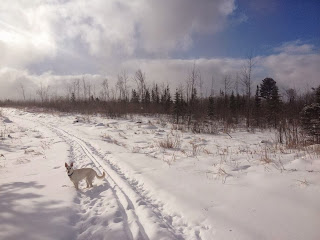--------------------------------------------------------------
Cold weather challenges birds ability to survive in several unique ways. While many species of birds migrate to avoid these challenges other species have developed physical and behavioral adaptations that allow them to not only survive but thrive through the winter months.
-----------------------------------------------------------------
Physical Adaptations
-----------------------------------------------------------------
Feathers
Feathers make birds adaptable. Birds can live in some of the most extreme environments because
feathers are so good at helping birds thermoregulate (keeping their bodies at a comfortable temperature). Feathers are remarkable because they help all birds stay comfortable, no matter what climate they are in. For birds spending the winter in cold places they have many more down feathers which work to keep them warm.
Down feathers are small and have loose barbs which trap warm air. The down works like a warm insulating layer and on top there are feathers designed to keep out the wind and the water. These overlapping feathers work like shingles, shedding water and deflecting wind. This combination works much like the layers that people wear in the winter to keep warm, they trap in warm and keep out the cold.
Feathers make birds adaptable. Birds can live in some of the most extreme environments because
feathers are so good at helping birds thermoregulate (keeping their bodies at a comfortable temperature). Feathers are remarkable because they help all birds stay comfortable, no matter what climate they are in. For birds spending the winter in cold places they have many more down feathers which work to keep them warm.
Down feathers are small and have loose barbs which trap warm air. The down works like a warm insulating layer and on top there are feathers designed to keep out the wind and the water. These overlapping feathers work like shingles, shedding water and deflecting wind. This combination works much like the layers that people wear in the winter to keep warm, they trap in warm and keep out the cold.
Most birds don't have feathers on their legs and feet which leaves them exposed Heat sinks are parts of a system where heat is lost. Counter-Current Heat Exchange is used by birds to to minimizing their heat loss and preventing any damage to their feet from the cold.
Counter-current heat exchange works because birds arteries are wrapped around the veins in their legs. When these two vessels come in contact it allows the incoming warm blood from the heart to heat the cold blood coming from the feet. Exchanging heat prevents the bird's core from having to work as hard and keeps the feet from freezing.
Counter-current heat exchange works because birds arteries are wrapped around the veins in their legs. When these two vessels come in contact it allows the incoming warm blood from the heart to heat the cold blood coming from the feet. Exchanging heat prevents the bird's core from having to work as hard and keeps the feet from freezing.
-----------------------------------------------------------------
Behavioral Adaptations
-----------------------------------------------------------------
Constant Feeding
Birds can gain and lose weight more easily then people. Many birds, especially small ones will spend most of their time during cold weather feeding [1]. Crazed feeding allows them accumulate enough fat to make it through the next night. Many birds will spend all of their day light hours eating or looking for food when the weather is cold. Songbirds probably spend most of the day actively searching. Their need for food is the reason you see them pile onto birds feeders. Smaller birds have higher metabolisms then raptors so they need more fat for how big they are. These large fat reserves laid down every day will be burned off overnight due to their high energy requirement. Raptors will often revert to the least energetic method of searching for food. Raptors may soar or spend time just perched looking out for prey items.
Posture
Just like how a Northern Cardinal can change the position of the feathers in its crest, birds can change their body posture and feather position to keep themselves warmer. By puffing up and making themselves as round as possible birds conserve the most warmth. As a bird forms a more round shape the ratio of surface area (outside of the bird) to the volume (the body of the bird) changes so the surface area is minimized for a particular size of bird. By minimizing surface area the amount of heat which can be lost is limited and puffing up their feathers helps limit heat loss even more.
Birds have a very aerodynamic shape and by orienting themselves to face into the wind the wind passes over them quickly. This is especially important in wet environments since down feathers lose their warmth when wet. By facing into the wind the birds feathers can work like shingles and shed the rain, protecting their warm downy undercoat.
Birds have a very aerodynamic shape and by orienting themselves to face into the wind the wind passes over them quickly. This is especially important in wet environments since down feathers lose their warmth when wet. By facing into the wind the birds feathers can work like shingles and shed the rain, protecting their warm downy undercoat.
 |
| Bluebirds huddling for warmth (Michael L. Smith) |
Several species of birds have been documented to huddle together in the winter, often in cavities or nest boxes to keep warm [2, 3]. These flocks are typically the same species, but are not necessarily related family members. Both Eastern Bluebirds and House Wrens are known to do this. Providing shelter for roosting birds is one reason to leave birdhouses up over the winter.
Torpor
Most people are familiar with hibernation, but some bird species engage in another method of surviving daily torpor. Torpor is a bit different then hibernation, individuals come in and out of it on a daily basis, rather then a season one. Their body temperature is also not lowered as much as individuals who hibernate. It still serves the same purpose, lowering your body temperature means you have to use less energy to stay warm, If you were to encounter a bird who was in torpor it would probably appear to be sleeping but would not quickly awaken as you approached. This slow response to disturbance is one reasons individuals probably don't to into torpor every night, it leaves them more vulnerable to predators and other hazards, but when cold weather strikes it can be a valuable tool [4].
Most people are familiar with hibernation, but some bird species engage in another method of surviving daily torpor. Torpor is a bit different then hibernation, individuals come in and out of it on a daily basis, rather then a season one. Their body temperature is also not lowered as much as individuals who hibernate. It still serves the same purpose, lowering your body temperature means you have to use less energy to stay warm, If you were to encounter a bird who was in torpor it would probably appear to be sleeping but would not quickly awaken as you approached. This slow response to disturbance is one reasons individuals probably don't to into torpor every night, it leaves them more vulnerable to predators and other hazards, but when cold weather strikes it can be a valuable tool [4].
-----------------------------------------------------------------
How You Can Help
-----------------------------------------------------------------
While birds don't NEED your help to survive the winter, during extreme weather there are a few things you can do to assist birds in surviving cold weather.
High Quality Food - Suet might seem a little odd, since it's basically just animal fat with seed mixed in, but it's pure energy to many bird species and can be a very high quality food source. More important then the kind of food you put out is to decide whether or not you will be feeding all winter. If you not, its best to taper off the food in the fall instead of just stopping in the middle of a snow storm when birds may have difficulty scouting out alternative food sources.
Shelter - Plant evergreen shrubs (plants which keep their leaves or needles year round) around your yard so birds can find protection from the wind/rain/snow. To prevent your bushes from being used as cover for predators (such as cats) keep the bushes back from feeders and bird baths.
Water - Staying hydrated is just as important as food, and often more difficult to find. You can use a heater or dripping water to keep a bird bath open. During the winter it's often best to put sticks or other perches around the bird bath since birds wont want to actually bathe in cold temperatures. These perches allow them to get easy access to a drink.
-----------------------------------------------------------------
One of the remarkable things about birds is their ability to survive extreme conditions. Take some time over the winter and watch your local birds at the feeder and see if you catch them exhibiting any of these adaptations. And if you have any other bird questions drop us a line - naturalausterity@gmail.com
- Auriel
One of the remarkable things about birds is their ability to survive extreme conditions. Take some time over the winter and watch your local birds at the feeder and see if you catch them exhibiting any of these adaptations. And if you have any other bird questions drop us a line - naturalausterity@gmail.com
- Auriel
-----------------------------------------------------------------
[1] P1.101 Friday, Jan. 4 Do small wintering birds adjust their metabolic performance in response to perceived level of cold? MILBERGUE, M.*; BLIER, P.; VEZINA, F.; Univ. of Quebec in Rimouski; http://www.sicb.org/meetings/2013/schedule/abstractdetails.php?id=738
[2] Mayer, L., Lustick, S., Battersby, B. (1982) The Importance of Cavity Roosting and Hypothermia to the Energy Balance of the Winter Acclimatized Carolina Chickadee. International Journal of Biometeorology. Volume 26:3 p231-238 http://link.springer.com/article/10.1007/BF02184939
[3] Kendeigh, S. Charles. (1961) Energy of Birds Conserved By Roosting in Cavities. The Wilson Bulletin. Volume 73:2 p140-147 http://www.jstor.org/discover/10.2307/4158912?uid=36852&uid=3739536&uid=2&uid=3&uid=67&uid=36848&uid=62&uid=3739256&sid=21103359393693
[4] Geiser, F. and Ruf, T. (1995) Hibernation versus Daily Torpor in Mammals and Birds: Physiological Variables and Classification of Torpor Patterns. Physiological Zoology. Vol 68:8 p 935-966 http://www.jstor.org/stable/30163788
[3] Kendeigh, S. Charles. (1961) Energy of Birds Conserved By Roosting in Cavities. The Wilson Bulletin. Volume 73:2 p140-147 http://www.jstor.org/discover/10.2307/4158912?uid=36852&uid=3739536&uid=2&uid=3&uid=67&uid=36848&uid=62&uid=3739256&sid=21103359393693
[4] Geiser, F. and Ruf, T. (1995) Hibernation versus Daily Torpor in Mammals and Birds: Physiological Variables and Classification of Torpor Patterns. Physiological Zoology. Vol 68:8 p 935-966 http://www.jstor.org/stable/30163788


















